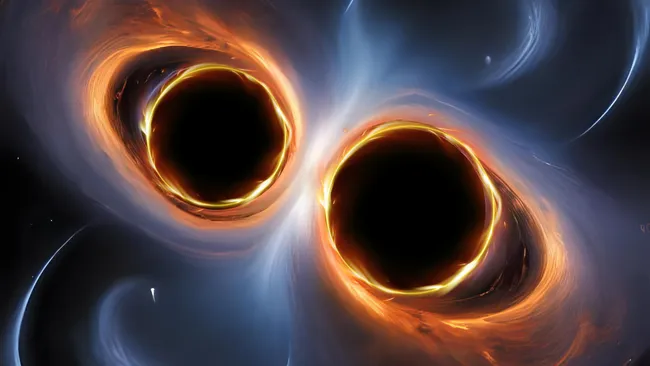Gravitational Waves Unveil Unprecedented Black Hole Merger, Challenging Stellar Evolution Theories
 |
| Two black holes collide and merge (Image credit: space.com) |
A groundbreaking discovery by gravitational wave observatories has revealed the most massive black hole merger ever detected, involving two colossal black holes whose existence, at their inferred masses, was previously considered "forbidden" by current astrophysical models. This monumental event, dubbed GW190521, offers a profound challenge to our understanding of how stars evolve and form black holes.
Gravitational waves, ripples in the fabric of spacetime, are a direct consequence of Einstein's theory of general relativity. These minuscule disturbances are generated by the most cataclysmic events in the universe, such as the collision and merger of black holes. The Laser Interferometer Gravitational-Wave Observatory (LIGO) in the United States, along with its European counterpart Virgo, are the pioneering instruments that detect these elusive waves, opening a new window to observe the cosmos.
The signal for GW190521, detected on May 21, 2019, was brief yet powerful, indicating an extraordinary event. Analysis of the waveform revealed the merger of two massive black holes: one approximately 85 times the mass of our Sun, and the other around 66 solar masses. Their catastrophic union resulted in an even more immense black hole, roughly 142 times the mass of the Sun, with the remaining energy radiated away as gravitational waves.
What makes this discovery particularly astonishing is the mass of the larger progenitor black hole, at 85 solar masses. This mass falls squarely into what astronomers refer to as the "pair-instability mass gap." According to current stellar evolution models, stars in a certain mass range (roughly 65 to 135 solar masses) are theorized to undergo a phenomenon called pair-instability supernova. In this scenario, the star becomes so hot and intense that gamma-ray photons convert into electron-positron pairs, reducing the internal radiation pressure. This collapse leads to a runaway thermonuclear explosion that completely disrupts the star, leaving no remnant black hole behind.
Therefore, the detection of an 85-solar-mass black hole, which should not exist based on these models, presents a significant puzzle. Several hypotheses are being explored to explain its origin. One possibility is that it formed through a previous "hierarchical merger" – the product of an earlier merger of two smaller black holes. Another intriguing idea is that it could have originated from the collapse of a Population III star, the universe's first generation of stars, which were metal-free and could have grown to enormous sizes, potentially bypassing the pair-instability mass gap.
Regardless of its exact formation mechanism, GW190521 unequivocally demonstrates that black holes exist within the forbidden mass range. This forces a re-evaluation of stellar evolution theories and our understanding of the pathways to black hole formation. It underscores the immense power of gravitational wave astronomy to not only confirm existing theories but also to push the boundaries of knowledge, revealing phenomena that challenge our most fundamental cosmic assumptions. As more gravitational wave events are detected, scientists anticipate further revelations that will continue to reshape our cosmic narrative.
Comments
Post a Comment